The Vernon Family
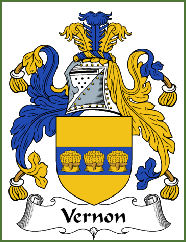 The wealthy and influential Vernon family, several branches of which held property in Cheshire and Derbyshire, originated from Vernon, in the Eure region of Normandy, where they were anciently seated at Vernon Castle.
The wealthy and influential Vernon family, several branches of which held property in Cheshire and Derbyshire, originated from Vernon, in the Eure region of Normandy, where they were anciently seated at Vernon Castle.
One of the early Coats of Arms granted to the family depicts a silver lion passant on a black shield. The tomb of William de Vernon, founder of the English Vernon family was destroyed during the French Revolution.
Vernon of Shipbrook, Cheshire
William's son Richard de Vernon, Seigneur de Reviers, Vernon, and Néhou was known to have fought at the Battle of Hastings along with his brother Walter, for which he was rewarded with lands in Cheshire under the patronage of Hugh d'Avranches, 1st Earl of Chester. Richard settled at Shipbrook, about 2 miles to the south east of Northwich and was created Baron of Shipbrooke, he was appointed as one of the eight barons under the Norman administration of Cheshire. Richard de Verno married Adzelia, the daughter of William Peverel, who was rumoured to be an illegitimate son of William the Conqueror.
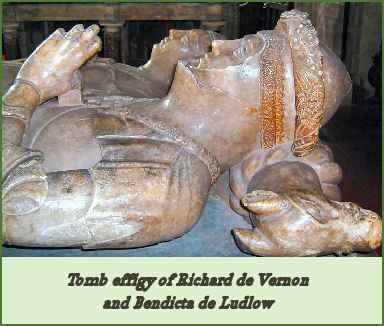 He was a faithful adviser of the Conqueror's youngest son, King Henry I, and aided him in his struggle against his brother Robert Curthose for control of the English throne. He witnessed more than 20 of Henry's charters & royal writs, in several different places, and sometimes as the only witness. By the time of his death in 1107, de Vernon had risen to become one of the richest and most powerful barons in England. Henry I rewarded him with several large grants of land, these included the honours of Plympton in Devon, Carisbrooke on the Isle of Wight and Christchurch in Hampshire. In addition to these he held estates in Normandy in the Cotentin and he had also acquired the manors of Crowell in Oxfordshire and Woolley in Berkshire on his marriage. Richard died on 8th September 1107 and was buried at his foundation of the Abbey of Montebourg in Normandy. Following his death his loyalty was remarked upon by the saintly Anselm of Canterbury. He left 3 sons, Badwin de Vernon, who became 1st Earl of Dorrset, William de Vernon, Lord of Vernon, who commanded a company of perhaps the first Welsh archers to be used in the Norman wars, and was later a travelling judge with County Geoffrey Plantagenet in Normandy. The third son was Hugh de Vernon, Baron of Shipbrook, from whom the Shipbrook Vernons descend.
He was a faithful adviser of the Conqueror's youngest son, King Henry I, and aided him in his struggle against his brother Robert Curthose for control of the English throne. He witnessed more than 20 of Henry's charters & royal writs, in several different places, and sometimes as the only witness. By the time of his death in 1107, de Vernon had risen to become one of the richest and most powerful barons in England. Henry I rewarded him with several large grants of land, these included the honours of Plympton in Devon, Carisbrooke on the Isle of Wight and Christchurch in Hampshire. In addition to these he held estates in Normandy in the Cotentin and he had also acquired the manors of Crowell in Oxfordshire and Woolley in Berkshire on his marriage. Richard died on 8th September 1107 and was buried at his foundation of the Abbey of Montebourg in Normandy. Following his death his loyalty was remarked upon by the saintly Anselm of Canterbury. He left 3 sons, Badwin de Vernon, who became 1st Earl of Dorrset, William de Vernon, Lord of Vernon, who commanded a company of perhaps the first Welsh archers to be used in the Norman wars, and was later a travelling judge with County Geoffrey Plantagenet in Normandy. The third son was Hugh de Vernon, Baron of Shipbrook, from whom the Shipbrook Vernons descend.
Another Richard de Vernon, a favourite of King John, was appointed High Sheriff of Lancashire from 1200-1205. Warren Vernon, the elder son of the 4th Baron and grandson of Hugh, married Margaret, daughter of Ralph de Andeville but was killed in battle in France and left no male heir. His extensive estates after a prolonged litigation, were divided between his 3 daughters and his brother Ralph, Rector of Hanwell.
On becoming de jure Baron of Shipbrook, Ralph Vernon set aside his vow of celibacy and produced a son with Cecilia Crew, there was rumoured to be no marriage certificate. He left further issue by Maud Grosvenor. Ralph's son, also Ralph (born 1241), was reputed to have lived to such an extraordinary age that he earned the nickname 'The Old Liver'. According to all official English records, he lived until 1392, aged an amazing 150 years. If in fact true, he may well have been one of the oldest men in recorded history, although a Russian is claimed to have lived to 162 years old. Ralph married twice and outlived most of his many great-grandchildren.
His grandson Sir Richard Vernon, who was born in 1355 at Shipbrook and features in Shakespeare's play Henry IV. Sir Richard was captured following the Battle of Shrewsbury in 1403, after joining the ill fated rebellion of the famous Harry Hotspur, he was beheaded for treason on the orders of the first Lancastrian king, Henry IV. The barony of Shipbrook was then inherited by Sir Ralph Vernon of Hanwell, a great-grandson of Ralph 'The Old Liver's' oldest son, Sir Ralph. He died without an heir in 1404.
Vernon of Nether Haddon and Tong
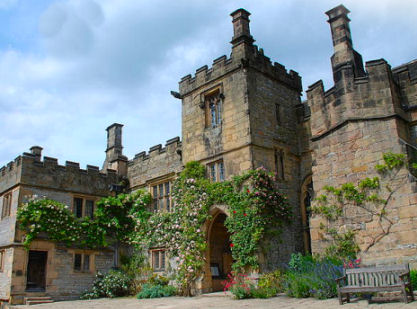 Other branches of the Vernon family fared better and their influence spread beyond Cheshire in the centuries which followed. During the reign of Henry III, Sir Richard de Vernon (died circa 1215) acquired the manor of Haddon in Derbyshire by his thirteenth century marriage to Alice Avenell, daughter of William Avenell and heiress of Nether Haddon and Haddon Hall. (pictured below left) The Vernons were responsible for most of the buildings at Haddon Hall, apart from the Peveril Tower and part of the Chapel, which were already existed in 1170.
Other branches of the Vernon family fared better and their influence spread beyond Cheshire in the centuries which followed. During the reign of Henry III, Sir Richard de Vernon (died circa 1215) acquired the manor of Haddon in Derbyshire by his thirteenth century marriage to Alice Avenell, daughter of William Avenell and heiress of Nether Haddon and Haddon Hall. (pictured below left) The Vernons were responsible for most of the buildings at Haddon Hall, apart from the Peveril Tower and part of the Chapel, which were already existed in 1170.
Their son, Sir William Vernon, was appointed High Sheriff of Lancashire and Chief Justice of Cheshire 1229–1236, the families fortunes increased through a series of advantageous dynastic marriages, Sir William's descendant, another Richard Vernon, married Juliana, daughter of Sir Fulk de Pembrugge, the heiress of Tong Castle, Shropshire in the mid fourteenth century.
Sir Richard Vernon (1390–1451) of Haddon and Tong married his distant cousin, the heiress Benedicta de Ludlow, daughter of Sir John de Ludlow and Isabella de Lingen. Benedicta de Ludlow, as well as the Lingen and Pembrugge Arms, are depicted in a stained glass gothic style window at Haddon Hall, which has an inscription requesting prayers for Sir Richard and his wife Benedicta.
Benedicta's mother, Lady Isabella Pembrugge founded the chantry and college at Tong in memory of her three husbands. The Church contains many fine Vernon family tombs. Sir Richard was bom in 1390 and was created a Knight in 1418. He was a Member of Parliament and Speaker of the House of Commons when it met at Leicester in 1426. In 1444 he was appointed Treasurer of Calais, a post he resigned in favour of his son, Sir William Vernon, in 1450. Sir William also became Knight Constable of England to King Henry VI.
Sir Henry Vernon (1441–1515) became governor and treasurer to Arthur, Prince of Wales, the elder brother of King Henry VIII. Arthur was made Prince of Wales in 1499 and the Government of Wales was vested in him with Sir Henry Vernon as his chief Counsellor. There is a tradition that the Prince frequently lived with Sir Henry at Haddon, where there was an apartment called the Prince's Chamber, with his arms cut in several places. Sir Henry married Anne Talbot, the daughter of the Earl of Shrewsbury and rebuilt Haddon Hall.
His son, another Richard Vernon, married Margaret Dymmoke, the daughter of Sir Robert Dymmoke , the King’s Champion at the coronations of the last Plantagenet King Richard III and the first two Tudor Kings, Henry VII and Henry VIII. The fine tomb effigies of Richard and Margaret Vernon may be seen at Tong church. Sir Arthur Vernon 1482-1517, the fifth son of Sir Henry and rector of Whitchurch, is also commemorated by a bust in the church.
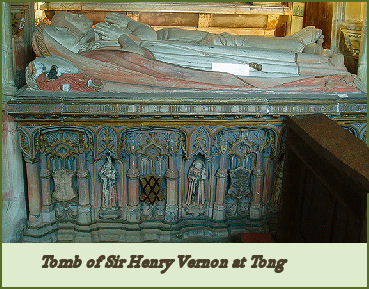 Sir Richard's son, Sir George Vernon (c. 1503 – August 31, 1565), who inherited Haddon Hall at the age of 9, was the last of the Haddon Vernons, he owned a huge estate and was styled King of the Peak. He was knighted at King Edward VI's coronation and was renowned for his love of entertaining and his heavy-handed discipline, in 1564 Bishop Bentham, an ardent reformer, recorded of him ‘a great justice [in] religion as in all other things’, renowned ‘for his magnificence ... for his kind reception of all good men, and his hospitality’.
Sir Richard's son, Sir George Vernon (c. 1503 – August 31, 1565), who inherited Haddon Hall at the age of 9, was the last of the Haddon Vernons, he owned a huge estate and was styled King of the Peak. He was knighted at King Edward VI's coronation and was renowned for his love of entertaining and his heavy-handed discipline, in 1564 Bishop Bentham, an ardent reformer, recorded of him ‘a great justice [in] religion as in all other things’, renowned ‘for his magnificence ... for his kind reception of all good men, and his hospitality’.
 Sir George died in 1565 without a male heir and his estates passed to his daughters, Margaret and Dorothy. Dorothy Vernon married John Manners, the second son of Thomas Manners, 1st Earl of Rutland in 1563. Sir George is said to have disapproved of the union on religious grounds (the Manners were Protestants, while the Vernons were Roman Catholics) and wished his daughter to marry her cousin, John Vernon, to ensure the Haddon lands remained in the Vernon name. Legend relates that Sir George ordered John Manners to cease courting the beautiful Dorothy and forbade his daughter from seeing Manners.
Sir George died in 1565 without a male heir and his estates passed to his daughters, Margaret and Dorothy. Dorothy Vernon married John Manners, the second son of Thomas Manners, 1st Earl of Rutland in 1563. Sir George is said to have disapproved of the union on religious grounds (the Manners were Protestants, while the Vernons were Roman Catholics) and wished his daughter to marry her cousin, John Vernon, to ensure the Haddon lands remained in the Vernon name. Legend relates that Sir George ordered John Manners to cease courting the beautiful Dorothy and forbade his daughter from seeing Manners.
In the course of a ball at Haddon Hall, given to celebrate the marriage of her elder sister in 1563, Dorothy slipped away and fled through the gardens to meet Manners by a footbridge, the couple then eloped. Their marriage could have taken place at Sir George's manor at Aylestone, Leicestershire or Bakewell church, although no written record survives. Dorothy was in time forgiven and two years later Dorothy and John Manners inherited the estate on the death of her father. Their grandson, John Manners of Haddon, inherited the Earldom of Rutland in 1641, on the death of his distant cousin, George, the 7th Earl.
Vernon of Lostock and Haslington
Sir Thomas Vernon, the second son of Sir Ralph Vernon, married Joan Lostock, heiress of Lostock Gralam and made Haslington in Cheshire his seat. The Barony of Shipbrook was inherited by to Sir James Vernon of Lostock and Haslington, who became the 10th Baron, on the death of Sir Ralph Vernon, last of the original Shipbrook line of Vernons. Timber framed Haslington Hall which lies 1 km to the east of the village, was built by Admiral Sir Francis Vernon, who sailed with Sir Francis Drake against the Spanish Armada, in 1545. Eleven generations of his descendants lived at Haslington until Muriel, daughter and heiress of Sir George Vernon, married her relation Sir Henry Vernon (1616–1658) of Sudbury Hall, in Derbyshire and their estates were merged.
Vernon of Sudbury and Hilton
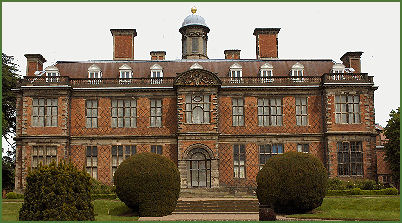 Sudbury became the property of the Vernon family in the early sixteenth century, when Ellen Montgomery, heiress of Sir John Montgomery (d 1513) of Marchington and Sudbury, married Sir John Vernon (d.1545), High Sheriff of Derbyshire and Nottinghamshire, a younger son of Henry Vernon of Haddon Hall.
Sudbury became the property of the Vernon family in the early sixteenth century, when Ellen Montgomery, heiress of Sir John Montgomery (d 1513) of Marchington and Sudbury, married Sir John Vernon (d.1545), High Sheriff of Derbyshire and Nottinghamshire, a younger son of Henry Vernon of Haddon Hall.
Their son Henry Vernon (died 1569) married Margaret Swynnerton, co-heiress of Humphrey Swynnerton of Hilton Hall, therby adding to his already substantial wealth. Neither of their sons left a male heir, but their son Henry's daughter, Margaret, married her third cousin Sir Edward Vernon (1584–1658) of Houndshill in Staffordshire. Their eldest son, Henry Vernon (1615–1659), married his relation Meriall Vernon, only daughter of Sir George Vernon of Haslington. The substantial estates were inherited by their eldest son George.
Imposing Sudbury Hall, (pictured right) one England's finest Restoration mansions, was built by George Vernon in the second half of the seventeenth century.The hall boasts exquisite plasterwork and wood carvings by Grinling Gibbons, including a splendid overmantel, and elaborate painted ceilings by Louis Laguerre.
George Vernon's grandson was created Baron Vernon of Kinderton in 1762. Sudbury was given to the Treasury in 1967 in part-payment of duties on the death of the 9th Lord Vernon. It was subsequently transferred to the National Trust. On the death of John Lawrance Vernon, the 10th Lord Vernon, the title was inherited by Anthony Vernon-Harcourt. the barony remains extant.
Vernon of Great Budworth, Gawsworth and Shotwick Park
William Vernon (1434–1507) of Cogshall, Great Budworth, Cheshire who was a grandson of Richard Vernon of Lostock. Thirteen generations of the family resided in Great Budworth and then Mutlow, Gawsworth. In 1914 William Vernon was created the first Baronet of Shotwick. The title is taken from Shotwick Castle built in Cheshire in the eleventh century by Hugh Lupus benefactor of the early de Vernon family. The Baronetcy remains extant.
